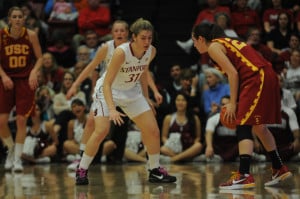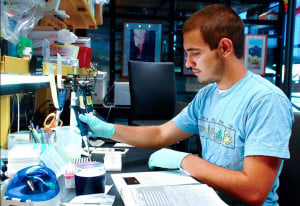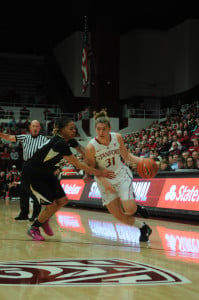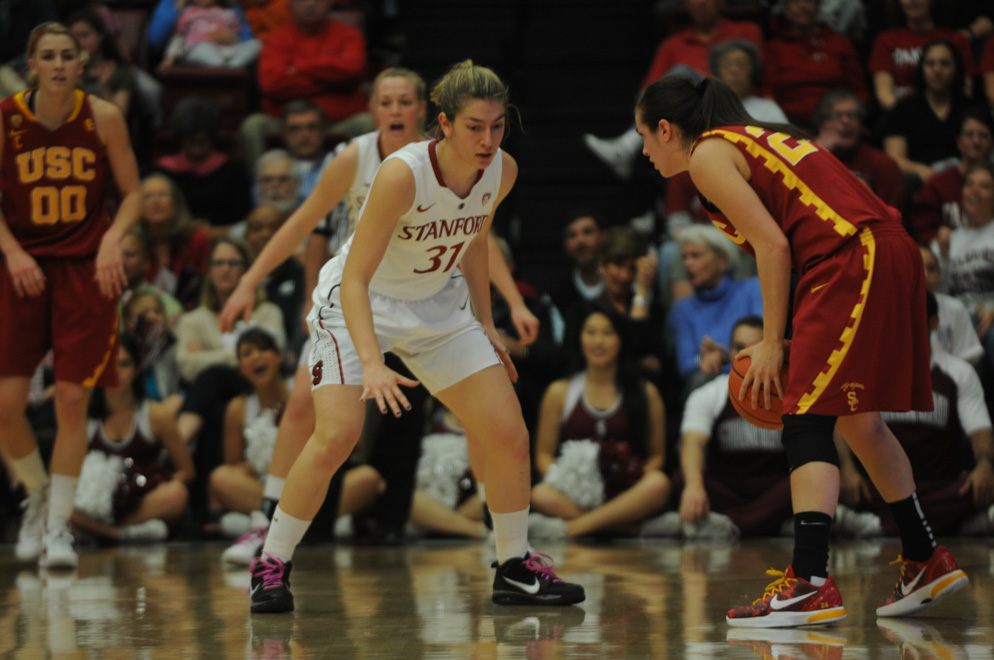“I remember thinking I was feeling fine and I played the rest of the game…we did the concussion tests and everything seemed okay. Then I woke up the next morning and everything was super foggy and I couldn’t really think straight. I could barely get out of bed. I just didn’t know what was happening.”

It was a scary situation for then-freshman women’s basketball player Toni Kokenis, who had hit the back of her head on the camera of a photographer during a game against UCLA after getting fouled hard on a layup attempt. Not only was the injury not readily apparent, but it also escaped immediate diagnosis, which likely magnified its effect after Kokenis had been allowed to re-enter the game.
The topic of concussions has come to the forefront of the athletic world within the last several years, at least in part due to increasing awareness of injuries like Kokenis’, as well as the emergence of long-term health detriments due to the improper handling of concussions and other traumatic brain injuries (TBIs).
Even though deterrence measures, like the newly established NCAA football targeting penalty — a 15-yard punishment for hits on defenseless players, particularly on the head or neck area — have been established to mitigate the effects of concussions, the nature of the injuries themselves and possible courses of action still largely remain a mystery.
Even as research tries to find answers to this mystery, the issue of concussions in sports remains very real, with lasting and significant effects on the athletes that suffer from them. Luckily for players like Kokenis, new research conducted at Stanford might bring the sports world closer to a better understanding of how to mitigate the effects of concussions.
***
Theo Roth ‘14 already knows that he wants to spend his life doing research. Even though he has juggled several other activities, such as playing the tenor saxophone in the Band, he maintained research as a focal point of his Stanford education and his academic career. Roth first started conducting research during the summer after his senior year of high school at the National Institutes of Health (NIH).

Although he participated in several projects when he first started, Roth began to work in neurosurgery as part of a project that enabled him to take live images of the outer layers of mice’s brains. Because he was learning a surgery that required specialized techniques that often took years to develop, Roth found himself making mistakes with the delicate techniques.
Even when he made mistakes that accidentally caused damage to the brains, however, he would still scan and take images of them. This led to an interesting discovery: The damaged cells didn’t die, but instead reacted more actively than expected.
Roth then collaborated with an MRI imagery expert to find interesting broader similarities in brain damage between human patients suffering from mild traumatic brain injuries and the damage to the mice brains in his experiments.
“That gave us hope that what we were doing in mice is actually biologically relevant to what happens in a brain during mild traumatic brain injury,” Roth said.
The discovery led to further exploration of the various types of cells involved in the brain injuries of mice, as well as these cells’ functions; in turn, the researchers uncovered the first stages of a possible therapeutic element that could potentially mitigate brain cell damage. And while Roth’s research represented progress, a significant hurdle still remained — the delivery of the drug to the brain.
“It’s very difficult to get anything to the brain at the site of injury,” Roth said. “And so there’s lots of drugs that have been previously identified — including the one that we used — as being protective in traumatic brain injury, but that’s only effective if you gave it before the injury or injected it straight into where the injury happened.”
Essentially, this meant that ongoing research allowed for the development of a therapeutic response that could act similarly to a vaccine with a more preventative element, but would not have much use if a quick response was needed.
Even with the headway made on the issue of response to TBIs, an equally significant question lies on the other side of the problem that Roth’s research: How to diagnose and characterize a concussion.
***
The concussion that Kokenis suffered against UCLA was neither her first nor her last. Of the four concussions that she endured, the first occurred in her junior year of high school, while the other three at Stanford occurred in her freshman, sophomore and junior years, respectively.
For all three concussions that she suffered while at Stanford, Kokenis found herself confused and dissatisfied with the protocol that existed within the athletics department in dealing with her injuries. Due to the long-term impact that concussions can have — Kokenis suffered from after-effects for months after each concussion — she was unable to simply “wait out” the injury and recover properly according to the athletic department’s procedure. Instead, Kokenis had to keep up with the work and the other elements of her Stanford experience despite still dealing with the after-effects of her concussion.

“I missed one midterm for a class, and I had the next one coming up the next week, and I missed that,” Kokenis said of her third concussion. “So I had this struggle of trying to get back into work so I didn’t fall super far behind, so it wasn’t like I could just not do anything and be totally fine. You have to try to find a way to keep up with everything.”
As a result of her continual efforts to close out the school year, Kokenis wasn’t able to use the respite from basketball to recover. Later, when the summer came around and workouts began once again, Kokenis started the “return-to-play protocol” to try and get back into basketball but found herself continuing to struggle with the injury.
“That was just a long summer,” Kokenis said. “I would just do a little bit, and then I would feel horrible, and then I couldn’t progress and would have to take a day off because I would have symptoms. And then I’d go back to it. I was doing a lot better when I got back to school, but I wasn’t at the same level as my teammates.
“It’s like, ‘Why can’t you [do the conditioning tests]? You should be able to do them by now.’ So it was really hard trying to find a balance…what is too much? Since nobody knows anything.”
The reason why Kokenis found herself so unclear and confused about her ultimate road to recovery was because of the loose, relatively unstructured protocol that the athletic department instituted for concussions. While the department offered her general guidelines with regards to the various “steps” in the process, the guidelines often left her with more questions than answers.
The protocol involved activities at different stages of rigor, like a light bike ride, an intense bike ride, a weightlifting session and a run; Kokenis would need to “step up” the activity based on whether she was asymptomatic for the 24 hours following each step.
But what if she was not feeling well at a certain stage for an extended period of time? Should she stay at the same step? Should she take a step back? Should she take a break for a while and start over? There were many questions, and few answers. This was not necessarily the fault of the athletic department; the uncharacterized nature of concussions and traumatic brain injuries has not allowed for the development of a definitive protocol yet.
“It’s so up in the air,” Kokenis said. “And that’s what’s frustrating. I wouldn’t blame the athletic department for not knowing this; it’s so individual. What I may be able to do at stage one and be totally fine could be too much for somebody else to do. So how do you decide what is the right amount to do?
“It was frustrating as an athlete not really having a structure to go by,” she continued. “Which was frustrating but at a time nice, because when I was home, my workouts were in my own hands and I could more so go on how I was feeling.”
Over the summer, as she recovered at home, Kokenis benefited strongly from being able to intersperse her workouts between naps, which allowed her to recover at her own pace. However, when she returned to campus for team workouts, the more rigid structure of longer practices resulted in her condition deteriorating, leaving Kokenis not feeling like herself. As such, she entered her junior season at a lower level than the rest of her teammates.
Then, the straw that broke the camel’s back came during a Feb. 3, 2013 matchup against Oregon State, when she hit her head again while boxing out. At that point, after all she had been through — all of the uncertainties and hardships — she knew it was over.
“Once I got my fourth, it was not worth it,” she said. “I hadn’t felt like myself for a year, basically. It wasn’t worth going through for anything.”
***
While some athletes like Kokenis are willing or able to make the decision for themselves to quit their sports due to the effects of their concussions, there are others that might not take the issue as seriously or have the presence of mind to realize the severity of concussions, especially given the fact that they don’t manifest as obviously as purely physical injuries like pulled muscles or torn ligaments.
“The important thing to realize about a TBI is that it’s not like a virus or a bacteria or certain cancers where once we find that magic drug, it’ll be fine,” Roth said. “Even within the first few minutes after a traumatic brain injury, there is essentially irrevocable damage done to the lining of the brain. It doesn’t matter what drugs you put in; you’re not going to be able to reform that. The best you can hope for is to limit the spread of that damage.”
With recent reports showing that former NFL players are suffering from permanent mental side effects due to the beatings that their brains endured during their playing careers, the potential consequences of concussions are starting to emerge within society, leading to more and more cases like that of Kokenis in which athletes choose to give up their sports for their personal safety.
But even with the danger of concussions looming, there will always be athletes that choose to swallow the risks and continue to play their sports, leaving the science and research to hurry to catch up.
While that decision is ultimately made on a personal level by each and every athlete, the fact remains that regardless of how many years pass, how many millions of dollars of funding go into research and how many people dedicate their time to pursuing new information about TBIs, there will never a point at which the effects of concussions can be completely “treated” — something that athletes and fans often might not understand.
“Diagnosis will get better, we’ll be able to more accurately predict people who have had a traumatic brain injury that will be severe enough to warrant treatment,” Roth said. “At some point, we’ll probably have drugs, whether the ones that we looked at or other stuff that nobody’s thought of yet that will be therapeutic and neuroprotective after a traumatic brain injury, but you’ll never alleviate all of it.”
With that in mind, at what point should athletes make the decision to preserve their well-being at the cost of something that they love? That’s a question whose answer will ultimately evolve as what researchers and doctors know and can do changes over the next several years. But through it all, Kokenis believes that it is important to keep things in a wider perspective.
“The athlete is still a human being, and this is their life,” she said. “Yes, there may be an important game the next day, but this is their brain you’re talking about. If they have a messed-up ankle…it’s not going to impact who they are as a person and their decision-making and their mood like having a brain injury does.”
Contact Do-Hyoung Park at dpark027 ‘at’ stanford.edu.
